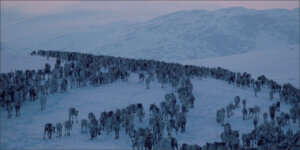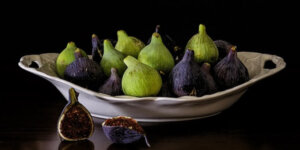The Man Who Planted Trees Before His Time

Though nature can be a mighty force, it takes great care and a gentle hand to support the growth of the environment–especially trees. Trees are essential for life; they create oxygen and are home to thousands of species, yet we’re experiencing rapid deforestation.
It only takes one person to plant one tree in their community to begin making a change. Start small–acorn small.
The following is an excerpt from The Man Who Planted Trees by Jean Giono. It has been adapted for the web.
The shepherd went to fetch a small sack and poured out a heap of acorns on the table. He began to inspect them, one by one, with great concentration, separating the good from the bad. I smoked my pipe. I did offer to help him. He told me that it was his job. And in fact, seeing the care he devoted to the task, I did not insist.
That was the whole of our conversation. When he had set aside a large enough pile of good acorns he counted them out by tens, meanwhile eliminating the small ones or those which were slightly cracked, for not he examined them more closely. When he had this selected one hundred perfect acorns he stopped and we went to bed.
There was peace in being with this man. The next day I asked if I might rest here for a day. He found it quite natural—or, to be more exact, he gave me the impression that nothing could startle him.
The rest was not absolutely necessary, but I was interested and wished to know more about him. He opened the pen and led his flock to pasture. Before leaving, he plunged his sack of carefully selected and counted acorns into a pail of water.
I noticed that he carried for a stick an iron rod as thick as my thumb and about a yard and a half long. Resting myself by walking, I followed a path parallel to his. His pasture was in a valley. He left the dog in charge of the little flock and climbed toward where I stood.
I was afraid that he was about to rebuke me for my indiscretion, but it was not that at all: this was the way he was going, and he invited me to go along if I had nothing better to do. He climbed to the top of the ridge, about a hundred yards away.
There he began thrusting his iron rod into the earth, making a hole in which he planted an acorn; then he refilled the hole. He was planting oak trees. I asked him if the land belonged to him. He answered no. Did he know whose it was? He did not.
He supposed it was community property, or perhaps belonged to people who cared nothing about it. He planted his hundred acorns with greatest care.
The Man Who Planted Trees by Jean Giono is the story of a man after my own heart. Elzeard Bouffier plants trees because he can see how ruinous everything is without them. He decides to plant hundreds of thousands of trees, and slowly the community of humans and animals around him comes back to life. His village and the countryside around it thrive, and that is reward enough for this humble man.

Image from The Man Who Planted Trees
I first became aware of this importance of trees as a little girl, when my grandmother told me that I should not collect wood from a nearby fig tree because it was a gift from God.
Even though I didn’t know then why fig trees were special, I later understood that the fig tree’s deeps roots tapped into underground streams and brought water to the surface, replenishing the land and bringing it life.
Unfortunately, that indigenous wisdom, like the tree, did not survive the forces of colonialism and globalization. The pure stream where I used to play with frogspawn and tadpoles dried up, like the tree a victim of shortsighted forestry practices and the growing of cash crops.
I began to plant trees with the Green Bet Movement (GBM), an organization I founded in 1977. Rural women in Kenya had been telling me that they had to walk further and further to collect firewood for fuel.
Their families were malnourished and their land was degraded. I saw that planting trees could provide these women with firewood, fruit, fodder, for their livestock, and fencing for their land, and also stop soil erosion and keep streams flowing.
Like the narrator of The Man Who Planted Trees, I saw human communities restored along with nature. This is not a mystical phenomenon; it is a fact of nature. Human beings cannot thrive in a place where the natural environment has been degraded.
It is interesting that Elzeard Bouffier continues his work of planting trees through two world wars and that the narrator notices that people in the village become more kindly and optimistic once the trees have grown. So much conflict over the last hundred years has been about access to natural resources—to land, oil, minerals, timber, and water.
In my effort to describe the linkage between good management of the environment, democratic space and peace, I have adopted a metaphor of the three-legged African stool. The three legs represent basic pillars for stable nations without which sustainable development is unattainable.
By linking environment, democracy, and peace, the Norwegian Nobel Committee expanded the concept of peace and security, and validated my long-held belief that only through and equitable distribution of those resources and their sustainable use will we be able to keep the peace. I feel that, in his quiet way, Elzeard Bourffier understands that, too.
I was amused by the narrator’s observation that the professionals from the Forest Service offer only “a great deal of ineffectual talk” when they come to inspect the forest that has grown us because of Elzeard Bouffier’s efforts.
When we women of the GBM went to the professional foresters to ask them for seedlings, we were told we weren’t qualified to plant trees. Now, women have been planting things in the ground for many centuries, and I didn’t think we needed a diploma to do the same with trees.
So we “foresters without diplomas” planted trees much like Eleard Bouffier did, by cultivating the seedlings and putting them in the ground. Since we started, we have planted thirty million trees throughout Kenya and expanded into other parts of Africa.
The Green Belt Movement and The Man Who Planted Trees make a very important point: you do not need a diploma to make a difference; everyone is qualified to save the planet.
The Man Who Planted Trees is a charming story about the virtues of environmental stewardship and tireless service—both of which are very important. However, it is also a vision of the good things that happen when we care for the world around us, and take what was barren and make it green. I hope you will let the story of Elzeard Bouffier inspire you to plant trees wherever you can.
-Wangari Maathai
Recommended Reads
Recent Articles
You know of Dasher, Dancer, Prancer & Vixen. Comet, Cupid, Donner & Blitzen. Rudolph too! But have you heard of the Sámi people who herd reindeer in Norway?
Read MoreWintergreen is the stunning evergreen groundcover that’s a game-changer for your garden! It’s cherished for its aromatic leaves, vibrant fall color & bright berries.
Read MoreThe fig tree is more than just a fruit-bearing wonder. The complex nature of these trees is beyond fascinating. They are the ultimate ecosystem superheroes!
Read MoreThe dirty truth? Soil isn’t just dirt! It’s a complex web of life. Discover the secrets to unlocking its full potential and transform your garden forever.
Read More








